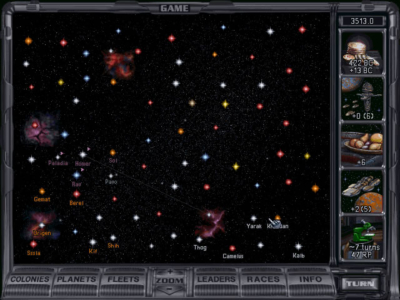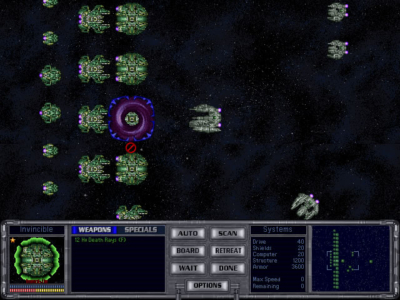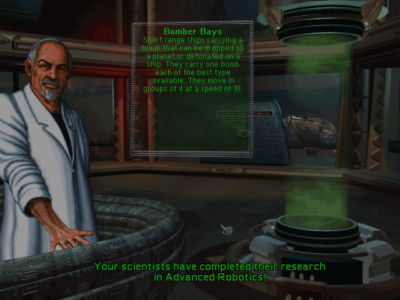
Master of Orion 2
Written by: Stoo
Date posted: November 1, 2001
- Genre: Strategy
- Developed by: Simtex
- Published by: Microprose
- Year released: 1996
- Our score: 9
Another of those space-empire titles, you are the Emperor of a race beginning its conquest of the stars. Your job is to establish and maintain colonies on new worlds, direct the scientific advances of your people and also command your fleet for the purposes of defence or warmongering.
The pic to the left shows the starmap, which serves as a kind of hub for the various screens and functions that pop up. Sadly it’s stuck in 2 dimensions (few games seem to take advantage of the full three dimensions of space), but the interface is very quick and efficient to use. Click on a star and a window appears displaying info abut what planets orbit that star and who owns them. If a planet is yours, you can click it to get on with managing construction down there or allocating your population to work. Meanwhile, fleets are represented as little icons, more on them later.
The meat of these games is certainly in the management, especially on the colonies, so thankfully this aspect is quite straightforward in MOO2. If you’ve played civilisation or any of its descendants you’ll quickly see some similarity. You allocate your population to producing food, industry or research. How much they can churn out per person depends on the type of planet, as do max population and growth rate; planets vary in mineral abundance and also environment. Various structures can be built on a colony to extend production or for defence – there’s a lot to remember in terms of what does what, but each structure has a clearly-defined purpose and makes a noticeable difference.
As you might hope for in a game like this, there’s a number of races to choose from, with widely varying advantages which alter how they handle. Some are superior traders, others technological wizards, and so on. Alternatively you can create your own custom race, choosing from wide range of attributes, each with a points cost. Aoart from simple bonuses to factors like industrial output, you can opt for features like doubling the population limit on planets, resistance to heavy gravity, greater morale and so on.
Right, colonies, races, what’s left.. of course, Starships. This is one of the highlights of Moo2, as you you can really go to town on designing classes of warship with more and more impressive hardware becoming available as research progresses. There’s over twenty weapon types, coming in two main flavours: beam (think Star-Trek phasors) or missile. Also you can add extra systems to enhance the ship, such as improving chance to hit with a beam, or tripling armour. (Some fundamental systems such as computers and engines are automatically fitted, as having thirty huge cannon of death isn’t much use if you can’t move). As you discover new weapons the older ones become more refined, taking up less space and gaining extra features and so giving them an extra lease of life. Also, if you conquer Orion (by defeating a guardian robot-ship-thingy) there’s some very tasty tech available that can’t be reached on the research tree. I appreciated this feature as it allows you to topple an enemy who’s far ahead in the research race and so dominating the game.
So in short, you have plenty of scope to build a fleet to your own specifications. If you want you can just fill up on heavy cannon and hope to murder everything in a massed barrage of fire. Alternatively you can be more cunning and reserve some space for extra systems to make the ship faster, or tougher, or a more difficult target etc. Of course, all this fiddling with ship designs is only half the issue; you want to know how much fun it is to use them in combat, right?
Ships appear in all their glory when combat takes place. Except graphically speaking it’s not that glorious, but still great fun. The game switches to a seperate combat screen which is again in a 2D arena, viewed from overhead with all the ships lined up in nice neat rows. The action is turn-based, with each side moving and firing with all their ships at once. When the two sides are reasonably evenly matched the combat can be a lot of fun; for example if you’ve just rolled out your new plasma-cannon-equipped battleships and want to see just how well they fare against the enemy fleet. Battles can even become quite exciting when you know the outcome will have major consequences for your empire, especially if your fleet is the last thing standing between your colonies and hordes of invaders.
On the harder settings the computer can churn out fleets that are truly monstrous in size, and you’ll be unlikely to keep up with ship production, as the AI players “cheat” with added boosts to their industry. Here superior technology is valuable; with it your ships can fend off several times their own number, so brute strength alone won’t always decide the winner.
One only small complaint here is that planetary defenses are almost a waste of time. Even the most powerful stations and missile batteries can be quickly annihilated by a few of the super-battleships that become available later on the in the game. Also I think the biggest, most powerful vessels should have been more restricted in numbers, perhaps by greater running costs to make fielding more than a few of them prohibitively expensive. You see, In the later stages of the game you’re pushed towards churning out rows of these monsters and ignoring all smaller and cheaper designs. I do think more balanced fleets, consisting of a few “super-battleships” plus larger numbers of cruisers and escorts might have been a bit more interesting, for the sake of variety and scope for tactics.
Anyhow, moving on: Ground combat on the other hand is very basic- you just take along x marines, the planet defends with y marines (also possibly z tanks), and you get to see them charge each other across a field. Success is a function of your numbers relative to the enemies, and also your tech level relative to theirs. There’s also a fairly simple spying system, where you set agents to steal tech from an alien race, sabotage their ships or defend your empire against enemy spies. It can be quite galling when an enemy race steals your latest missile technology but then, I suppose that’s all part of what an interstellar emperor has to deal with.
A final word for the computer players and your interactions with them. There’s a fully featured diplomacy system, where you can arrange non-aggresion pacts and alliances, and also push for treaties to mutually boost trade and research. There’s also the option to offer gifts (such as technology or money) or make demands. The AI of the computer-controlled empires isn’t particularly inspired, but it isn’t entirely moronic either, so your dealings with them can play a part in overall strategy. For example, regular gifts may placate an agressive enemy until your fleet is up to scratch.
You can of course win this game by wiping everyone out, but there is also the issue of the “galactic council” to worry about, which adds a bit of urgency to your empire-building. Every so often the races vote for one out of the two most populous of their number to rule the galaxy, with the strength of each race’s vote depending on their own population (and the contenders can of course vote for themselves). If you’re not in the running to win this yourself then you don’t want
either of the contenders to get the required 2/3 majority, as if there is a winner the entire galaxy unites against you. To fight this you must vote tactically to push for a stalemate, whilst trying to increase your own empire’s size, and gather supports from other races, so that you can hopefully run for leadership yourself next time (which wins you the game).
I’ve picked a few holes in Moo2 here, but only in the same way that hardcore Trekkies like to nitpick their favourite show. In fact, overall this game it’s one of the biggest time-eaters I’ve ever come across, firmly in the “I’ll just play for another hour…oh crap it’s 3am” category. Strategy of the turn-based kind may largely be fading into the past, but Moo2 is survivor of the breed and still stands as a true classic. There’s enough factors to juggle to keep you busy, but you can always see the results of your actions in terms of how events unfold in your empire. This means that you really feel in command of what’s going on, rather than spewing forth orders without really knowing if they had any effect, as is sometimes the case in strategy games. The level of control you’re given does lead to a certain amount of micro-management, but not an excessive level. With just the right level of detail to play with, those of you who fancy the challenge of ruling a star-spanning empire will find that Moo2 is still one of the top games of its type. You could well be sat there playing this well into the night, occasionally waving your fist at the screen and shouting “Damn those Silicoids, mobilise the fleet”.





 Posts
Posts